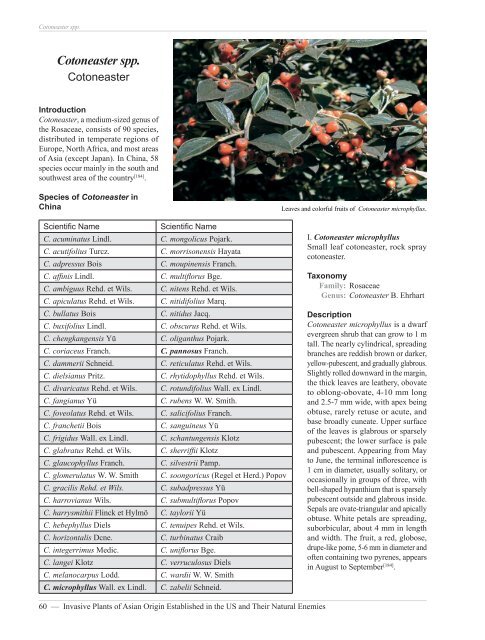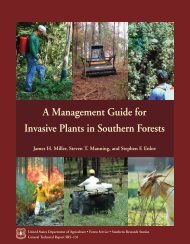Cotoneaster spp.
Cotoneaster spp.
Cotoneaster spp.
Create successful ePaper yourself
Turn your PDF publications into a flip-book with our unique Google optimized e-Paper software.
<strong>Cotoneaster</strong> <strong>spp</strong>.<br />
<strong>Cotoneaster</strong> <strong>spp</strong>.<br />
<strong>Cotoneaster</strong><br />
Introduction<br />
<strong>Cotoneaster</strong>, a medium-sized genus of<br />
the Rosaceae, consists of 90 species,<br />
distributed in temperate regions of<br />
Europe, North Africa, and most areas<br />
of Asia (except Japan). In China, 58<br />
species occur mainly in the south and<br />
southwest area of the country [184] .<br />
Species of <strong>Cotoneaster</strong> in<br />
China<br />
Leaves and colorful fruits of <strong>Cotoneaster</strong> microphyllus.<br />
Scientific Name<br />
Scientific Name<br />
C. acuminatus Lindl. C. mongolicus Pojark.<br />
C. acutifolius Turcz. C. morrisonensis Hayata<br />
C. adpressus Bois C. moupinensis Franch.<br />
C. affinis Lindl. C. multiflorus Bge.<br />
C. ambiguus Rehd. et Wils. C. nitens Rehd. et Wils.<br />
C. apiculatus Rehd. et Wils. C. nitidifolius Marq.<br />
C. bullatus Bois C. nitidus Jacq.<br />
C. buxifolius Lindl. C. obscurus Rehd. et Wils.<br />
C. chengkangensis Yü C. oliganthus Pojark.<br />
C. coriaceus Franch. C. pannosus Franch.<br />
C. dammerii Schneid. C. reticulatus Rehd. et Wils.<br />
C. dielsianus Pritz. C. rhytidophyllus Rehd. et Wils.<br />
C. divaricatus Rehd. et Wils. C. rotundifolius Wall. ex Lindl.<br />
C. fangianus Yü C. rubens W. W. Smith.<br />
C. foveolatus Rehd. et Wils. C. salicifolius Franch.<br />
C. franchetii Bois C. sanguineus Yü<br />
C. frigidus Wall. ex Lindl. C. schantungensis Klotz<br />
C. glabratus Rehd. et Wils. C. sherriffii Klotz<br />
C. glaucophyllus Franch. C. silvestrii Pamp.<br />
C. glomerulatus W. W. Smith C. soongoricus (Regel et Herd.) Popov<br />
C. gracilis Rehd. et Wils. C. subadpressus Yü<br />
C. harrovianus Wils. C. submultiflorus Popov<br />
C. harrysmithii Flinck et Hylmö C. taylorii Yü<br />
C. hebephyllus Diels C. tenuipes Rehd. et Wils.<br />
C. horizontalis Dcne. C. turbinatus Craib<br />
C. integerrimus Medic. C. uniflorus Bge.<br />
C. langei Klotz C. verruculosus Diels<br />
C. melanocarpus Lodd. C. wardii W. W. Smith<br />
C. microphyllus Wall. ex Lindl. C. zabelii Schneid.<br />
I. <strong>Cotoneaster</strong> microphyllus<br />
Small leaf cotoneaster, rock spray<br />
cotoneaster.<br />
Taxonomy<br />
Family: Rosaceae<br />
Genus: <strong>Cotoneaster</strong> B. Ehrhart<br />
Description<br />
<strong>Cotoneaster</strong> microphyllus is a dwarf<br />
evergreen shrub that can grow to 1 m<br />
tall. The nearly cylindrical, spreading<br />
branches are reddish brown or darker,<br />
yellow-pubescent, and gradually glabrous.<br />
Slightly rolled downward in the margin,<br />
the thick leaves are leathery, obovate<br />
to oblong-obovate, 4-10 mm long<br />
and 2.5-7 mm wide, with apex being<br />
obtuse, rarely retuse or acute, and<br />
base broadly cuneate. Upper surface<br />
of the leaves is glabrous or sparsely<br />
pubescent; the lower surface is pale<br />
and pubescent. Appearing from May<br />
to June, the terminal inflorescence is<br />
1 cm in diameter, usually solitary, or<br />
occasionally in groups of three, with<br />
bell-shaped hypanthium that is sparsely<br />
pubescent outside and glabrous inside.<br />
Sepals are ovate-triangular and apically<br />
obtuse. White petals are spreading,<br />
suborbicular, about 4 mm in length<br />
and width. The fruit, a red, globose,<br />
drupe-like pome, 5-6 mm in diameter and<br />
often containing two pyrenes, appears<br />
in August to September [184] .<br />
60 — Invasive Plants of Asian Origin Established in the US and Their Natural Enemies
<strong>Cotoneaster</strong> <strong>spp</strong>.<br />
Habitat<br />
<strong>Cotoneaster</strong> microphyllus occurs on<br />
rocky mountain slopes, in thickets,<br />
and in river valleys, at elevations of<br />
2,000–4,200 m [184] .<br />
Distribution<br />
<strong>Cotoneaster</strong> microphyllus occurs in<br />
Sichuan, Tibet, and Yunnan provinces<br />
[184]<br />
.<br />
Economic Importance<br />
<strong>Cotoneaster</strong> microphyllus is well suited<br />
for use as an ornamental because of its<br />
graceful white flowers in spring and<br />
brilliant red fruit in autumn [184] .<br />
Related Species<br />
There are 4 varieties within the<br />
species:<br />
1) <strong>Cotoneaster</strong> microphyllus var.<br />
conspiocuus Messel has a wider growth<br />
form and broader leaves and fruits, and<br />
occurs at elevations of 2,700–3,300 m<br />
in the Brahmaputra River valley, Tibet.<br />
The fruit has important ornamental value<br />
due to its persistent brilliant color.<br />
2) <strong>Cotoneaster</strong> microphyllus var. glacialis<br />
Hook. f. occurs in rocky mountainous<br />
areas at elevations of 3,900-4,200 m<br />
in southeastern Tibet.<br />
3) <strong>Cotoneaster</strong> microphyllus var.<br />
cochleatus (Franch.) Rehd. et Wils.,<br />
with revolute leaves, and occurs in<br />
Yunnan and Sichuan.<br />
4) <strong>Cotoneaster</strong> microphyllus var.<br />
thymifolius (Baker) Koehne has<br />
relatively narrow, revolute leaves and<br />
bright red fruit, occurs at elevations of<br />
3,000-4,000 m, in northwestern Yunnan,<br />
and southeastern Tibet [184] .<br />
II. <strong>Cotoneaster</strong> pannosus<br />
Taxonomy<br />
Family: Rosaceae<br />
Genus: <strong>Cotoneaster</strong> B. Ehrhart<br />
broadly cuneate at the base, with midrib<br />
impressed on the glabrous or sparsely<br />
pubescent upper surface and raised on<br />
the densely tomentose lower surface.<br />
Generally consisting of less than ten<br />
flowers (21 at the maximum), corymbs<br />
are 1-3 cm in diameter and 1.5-2.5<br />
cm in length, with dense hair-covered<br />
pedicel and rachis. Bracts are linear<br />
and caducous. Flowers are 8 mm in<br />
diameter, with bell-shaped calyx and<br />
triangular, apically short acuminate or<br />
acute sepals; both are glabrous inside<br />
and densely hairy outside. Petals are<br />
white, broadly ovate or subglobose,<br />
3-3.5 mm in length with an obtuse<br />
apex and a short claw-bearing base.<br />
Fruits are red, globose or ovate, 7-8<br />
mm in diameter, enclosing two pyrenes.<br />
Flowers appear in June to July and<br />
fruits in October [184] .<br />
Habitat<br />
<strong>Cotoneaster</strong> pannosus occurs in<br />
mountainous scrub land, rocky areas,<br />
or wastelands at elevations of 1,100-<br />
3,200 m [184] .<br />
Distribution<br />
<strong>Cotoneaster</strong> pannosus is native to<br />
Sichuan and Yunnan [184] .<br />
Related Species<br />
One variety, C. pannosus var. robustior,<br />
has narrowly elliptic leaf blades, and<br />
occurs in northwestern Sichuan.<br />
Another two cotoneasters are apparently<br />
similar to C. pannosus. C. franchetii<br />
Description<br />
<strong>Cotoneaster</strong> pannosus is a semievergreen<br />
shrub up to 2 m in diameter<br />
with arch-like branches. Branchlets are<br />
thin, dark brown, and initially covered<br />
with short, dense hairs that are shed<br />
as it matures. Leaves are elliptic or<br />
ovate, 1-2.5 cm long and 0.8-1.5 cm<br />
wide, obtuse or acute apically and<br />
<strong>Cotoneaster</strong> pannosus invading mountainous scrubland.<br />
Invasive Plants of Asian Origin Established in the US and Their Natural Enemies — 61
<strong>Cotoneaster</strong> <strong>spp</strong>.<br />
Bois is distinguished by the densely<br />
pubescent upper leaf surface, shorter<br />
petioles, erect petals, and orange fruits<br />
containing three pyrenes; C. silvestrii<br />
Pamp. has thinner leaves, which are<br />
sparsely hairy on the underside, and<br />
yellow stamens. The fruits contain a<br />
single pyrene. [184] .<br />
Natural Enemies of<br />
<strong>Cotoneaster</strong><br />
Eight fungi and three arthropods are<br />
reported to attack members of the genus<br />
<strong>Cotoneaster</strong>.<br />
Fungi<br />
Phylum Family Species H. R. Ref.<br />
Ascomycota Erysiphaceae Phyllactinia pyri (Castagne) Homma po 22<br />
Aecidium cunninghamianum Barclay mo 23<br />
Coleopuccinia kunmingensis F.L. Tai o 23<br />
Incertae sedis<br />
Roestelia nanwutaiana (T.L. Tai & C.C. Cheo)<br />
Basidiomycota<br />
Jørst.<br />
oo 23<br />
Roestelia sikangensis (Petr.) Jørst. oo 23<br />
Pucciniaceae<br />
Gymnosporangium clavariiforme (Jacq.) DC. po 23<br />
Gymnosporangium confusum Plowr. oo 23<br />
Anamorphic Mycosphaerella<br />
Pseudocercospora cotoneastri (Katsuki & Ts.<br />
Kobay.) Deighton<br />
oo 110 †<br />
†<br />
Recorded as Pseudocercospora cotoneasteris (Kats. et Kobayashi) Deighton<br />
Arthropods<br />
Order Family Species H. R. Ref.<br />
mo 140<br />
Coleoptera Scolytidae Scolytus abaensis Tsai et Yin<br />
oo 182<br />
Homoptera Pseudococcidae Pseudococcus comstocki (Kuwana) po 150<br />
oo 40 ‡<br />
Lepidoptera Arctiidae Arctia flavia (Fueszly)<br />
oo 41<br />
‡<br />
Recorded as Phragmatobia flavia (Fuessly)<br />
62 — Invasive Plants of Asian Origin Established in the US and Their Natural Enemies

















